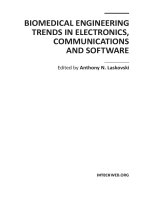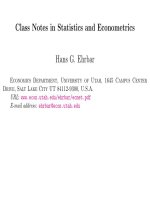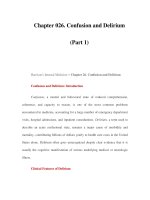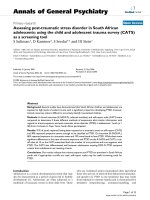ECG in the Child and Adolescent - part 1 pdf
Bạn đang xem bản rút gọn của tài liệu. Xem và tải ngay bản đầy đủ của tài liệu tại đây (131.82 KB, 10 trang )
P1: OTE/SPH P2: OTE
BLUK054-Lue June 23, 2006 11:2
ECG in the
Child and
Adolescent
NORMAL STANDARDS AND PERCENTILE CHARTS
i
P1: OTE/SPH P2: OTE
BLUK054-Lue June 23, 2006 11:2
ii
P1: OTE/SPH P2: OTE
BLUK054-Lue June 23, 2006 11:2
ECG in the
Child and
Adolescent
NORMAL STANDARDS AND
PERCENTILE CHARTS
Hung-Chi Lue,
M.D., Ph.D., F.A.C.C., F.C.C.P.
Attending Pediatric Cardiologist and Physician-in-Chief,
Min-Sheng General Hospital; and Emeritus Professor of Pediatrics,
College of Medicine, National Taiwan University
WITH THE COLLABORATION OF
Yung-Chang Lai,
M.D.
Mei-Hwan Wu,
M.D., Ph.D., F.A.C.C.
Jou-Kou Wang, M.D., Ph.D.
Ming-Lon Young, M.D., M.P.H.
Yung-Ching Chang,
M.D.
Shu-Jen Yeh, M.D.
Jiuann-Huey Lin, M.D.
iii
P1: OTE/SPH P2: OTE
BLUK054-Lue June 23, 2006 11:2
C
2006 by Blackwell Publishing
Blackwell Futura is an imprint of Blackwell Publishing
Blackwell Publishing, Inc., 350 Main Street, Malden, Massachusetts 02148-5020, USA
Blackwell Publishing Ltd, 9600 Garsington Road, Oxford OX4 2DQ, UK
Blackwell Science Asia Pty Ltd, 550 Swanston Street, Carlton, Victoria 3053, Australia
All rights reserved. No part of this publication may be reproduced in any form or by any electronic
or mechanical means, including information storage and retrieval systems, without permission
in writing from the publisher, except by a reviewer who may quote brief passages in a review.
First published 2006
1 2006
ISBN-13: 978-1-4051-5899-2
ISBN-10: 1-4051-5899-9
Library of Congress Cataloguing-in-Publication Data
Lue, Hung-Chi, 1931–
ECG in the child and adolescent : normal standards and percentile
charts / Hung-Chi Lue ; with the collaboration of Yung-Chang Lai
[et al.].
p. ; cm.
Includes bibliographical references.
ISBN-13: 978-1-4051-5899-2 (hardcover : alk. paper)
ISBN-10: 1-4051-5899-9 (hardcover : alk. paper)
1. Pediatric cardiology—Standards—Tables. 2. Electrocardiography—
Interpretation—Tables. I. Lai, Yung-Chang. II. Title.
[DNLM: 1. Electrocardiography—standards—Tables. 2. Adolescent.
3. Child. 4. Infant. WS 16 L948e 2007]
RJ423.5.E43L84 2007
618.92’12—dc22
2006014415
A catalogue record for this title is available from the British Library
Acquisitions: Gina Almond
Development: Fiona Pattison
Set in Palatino 9.5pt/12pt by TechBooks
Printed and bound in Singapore by COS Printers Pte Ltd
For further information on Blackwell Publishing, visit our website:
www.blackwellfutura.com
The publisher’s policy is to use permanent paper from mills that operate a sustainable forestry
policy, and which has been manufactured from pulp processed using acid-free and elementary
chlorine-free practices. Furthermore, the publisher ensures that the text paper and cover board
used have met acceptable environmental accreditation standards.
Blackwell Publishing makes no representation, express or implied, that the drug dosages in this
book are correct. Readers must therefore always check that any product mentioned in this pub-
lication is used in accordance with the prescribing information prepared by the manufacturers.
The author and the publishers do not accept responsibility or legal liability for any errors in the
text or for the misuse or misapplication of material in this book.
iv
P1: OTE/SPH P2: OTE
BLUK054-Lue June 23, 2006 11:2
Contents
Preface, ix
Foreword, xi
Introduction, xv
How to use this book, xvii
References, xviii
Part 1 Heart rate, P-QRS-T interval and duration by age
1.1 Heart rate by age, 3
1.2 PR interval by age, 4
1.3 PR interval by heart rate, 5
1.4 QT interval by age, 6
1.5 QT interval by heart rate, 7
1.6 QTc interval by age, 8
1.7 QTc interval by heart rate, 9
1.8 QRS duration by age, 10
1.9 RR interval by age, 11
Part 2 Frontal plane P-QRS-T axis by age
2.1 Frontal plane P axis by age, 15
2.2 Frontal plane QRS axis by age, 16
2.3 Frontal plane T axis by age, 17
Part 3 P-QRS-T amplitude by age
3.1 P amplitude by age in lead II, 21
3.2 Q amplitude by age in lead I, 22
3.3 Q amplitude by age in lead II, 23
3.4 Q amplitude by age in lead III, 24
3.5 Q amplitude by age in lead aVR, 25
3.6 Q amplitude by age in lead aVL, 26
3.7 Q amplitude by age in lead aVF, 27
3.8 Q amplitude by age in lead V4, 28
3.9 Q amplitude by age in lead V5, 29
3.10 Q amplitude by age in lead V6, 30
3.11 R amplitude by age in lead aVR, 31
3.12 R amplitude by age in lead V1, 32
v
P1: OTE/SPH P2: OTE
BLUK054-Lue June 23, 2006 11:2
vi Contents
3.13 R amplitude by age in lead V2, 33
3.14 R amplitude by age in lead V4, 34
3.15 R amplitude by age in lead V5, 35
3.16 R amplitude by age in lead V6, 36
3.17 S amplitude by age in lead I, 37
3.18 S amplitude by age in lead II, 38
3.19 S amplitude by age in lead III, 39
3.20 S amplitude by age in lead aVL, 40
3.21 S amplitude by age in lead aVF, 41
3.22 S amplitude by age in lead V1, 42
3.23 S amplitude by age in lead V2, 43
3.24 S amplitude by age in lead V4, 44
3.25 S amplitude by age in lead V5, 45
3.26 S amplitude by age in lead V6, 46
3.27 T amplitude by age in lead I, 47
3.28 T amplitude by age in lead II, 48
3.29 T amplitude by age in lead III, 49
3.30 T amplitude by age in lead aVR, 50
3.31 T amplitude by age in lead aVL, 51
3.32 T amplitude by age in lead aVF, 52
3.33 T amplitude by age in lead V1, 53
3.34 T amplitude by age in lead V2, 54
3.35 T amplitude by age in lead V4, 55
3.36 T amplitude by age in lead V5, 56
3.37 T amplitude by age in lead V6, 57
Part 4 Calculated values on RS amplitude and
ventricular activation time by age
4.1 R/S amplitude ratio by age in lead I, 61
4.2 R/S amplitude ratio by age in lead II, 62
4.3 R/S amplitude ratio by age in lead III, 63
4.4 R/S amplitude ratio by age in lead aVR, 64
4.5 R/S amplitude ratio by age in lead aVL, 65
4.6 R/S amplitude ratio by age in lead aVF, 66
4.7 R/S amplitude ratio by age in lead V1, 67
4.8 R/S amplitude ratio by age in lead V2, 68
4.9 R/S amplitude ratio by age in lead V3, 69
4.10 R/S amplitude ratio by age in lead V4, 70
4.11 R/S amplitude ratio by age in lead V5, 71
4.12 R/S amplitude ratio by age in lead V6, 72
4.13 R amplitude in lead V3 + S amplitude in lead V3 by age, 73
4.14 R amplitude in lead V6 + S amplitude in lead V1 by age, 74
4.15 R amplitude in lead V6 + S amplitude in lead V2 by age, 75
4.16 Ventricular activation time by age in lead I, 76
P1: OTE/SPH P2: OTE
BLUK054-Lue June 23, 2006 11:2
Contents vii
4.17 Ventricular activation time by age in lead II, 77
4.18 Ventricular activation time by age in lead III, 78
4.19 Ventricular activation time by age in lead aVR, 79
4.20 Ventricular activation time by age in lead aVL, 80
4.21 Ventricular activation time by age in lead aVF, 81
4.22 Ventricular activation time by age in lead V1, 82
4.23 Ventricular activation time by age in lead V2, 83
4.24 Ventricular activation time by age in lead V4, 84
4.25 Ventricular activation time by age in lead V5, 85
4.26 Ventricular activation time by age in lead V6, 86
P1: OTE/SPH P2: OTE
BLUK054-Lue June 23, 2006 11:2
viii
P1: OTE/SPH P2: OTE
BLUK054-Lue June 23, 2006 11:2
Preface
Electrocardiograms (ECGs) are the graphic representation of body surface po-
tential differences generated by the electrical activity of the heart. Bipolar limb
leads, augmented unipolar limb leads and precordial leads have been used rou-
tinely for recording the ECG, which remains an essential part of the cardiac
examination, even after the advent of cardiac catheterization, angiocardiogra-
phy, echocardiography and many other sophisticated diagnostic modalities.
Fundamental changes in circulation occur immediately after birth, followed
by typical and characteristic changes in physiology, position and size of the
cardiac chambers relative to the body, throughout infancy, childhood and ado-
lescence. Normal adult values are abnormal in children. Likewise, many of the
normal pediatric values are abnormal in the adult. Studies on the developing
ECGs reflecting these changes in the healthy pediatric population are of ut-
most importance, but are still few and limited. Reliable normal standards for
P-QRS-T wave intervals and amplitudes are needed as the reference for the
diagnosis and evaluation of children with heart disease. Traditionally, normal
ECG values in the pediatric population were derived from those published
by Ziegler RF (1951) and Davignon et al. (1979). We found that the available
interpretation packages were inadequate, and not easy to use.
Normal ECG standards for infants, children and adolescents provide not
only the reference for physicians in their daily practice of ECG reading, but
also provide the database for the study of growing and developing heart and
for the computer-assisted electrocardiography analysis. To establish such a set
of normal ECG standards and percentile charts in the young in 1995, we started
to collect and analyse the electrocardiographic data from healthy newborns,
infants, children and adolescents.
Thanks must go to Drs. Y. C. Lai, M. H. Wu, J. K. Wang, M. L. Young,
Y. C. Chang, S. J. Yeh, J. H. Lin, and Ms. S. C. Lin together with her team
of technicians, who collaborated in this study. Without their efforts collection
of the ECGs for analysis of normal standards and percentile charts would not
have been possible. The author is grateful to Dr. W. Y. Shau for his advice in
the statistical analysis of the normative data, and also to Ms. Renee Shen for
her secretarial work.
The author is grateful to the Fukuda Denshi for providing us the FCP-4301
Electrocardiograph with a 500 Hz acquisition program, as recommended by
the American Heart Association. Last but not least, the author is grateful to
Blackwell Publishing for their efforts in editing and printing.
Hung-Chi Lue
ix









